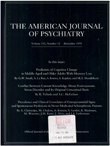Panic disorder in cardiac outpatients
Abstract
OBJECTIVE: Continuing the long history of interest in the relation of anxiety disorders to cardiovascular function and symptoms, this study investigated the level of anxiety and prevalence of panic disorder in cardiac patients and the possible associations between specific abnormal ECG results and a diagnosis of panic disorder. METHOD: Consecutive patients referred for ambulatory ECG recordings were assessed with the seven anxiety items of the Hospital Anxiety and Depression Scale. Then, 50 patients with scores higher than 8 (the anxious group) were interviewed with the Schedule for Affective Disorders and Schizophrenia--Lifetime Version Modified for the Study of Anxiety Disorders (SADS-LA). RESULTS: Of the 50 anxious patients (26 male and 24 female) interviewed with the SADS-LA, 62% (N = 31) met the DSM-III-R criteria for panic disorder. Patients with panic disorder had a higher mean maximal heart rate and a shorter P-R interval than patients without panic disorder. Unlike the patients without panic disorder, the patients with panic disorder showed no correlation between maximal heart rate and minimal P-R interval. CONCLUSIONS: The rate of panic disorder was high in the patients referred for ECG. Moreover, the prevalence of panic disorder was similar in the patients with and without ECG abnormalities, indicating that in anxious patients the presence of panic disorder does not rule out organic cardiac disease. On the other hand, the higher maximal heart rate and shorter P- R interval of the panic patients may be attributable to hypersensitivity of beta-adrenergic receptors in panic disorder.
Access content
To read the fulltext, please use one of the options below to sign in or purchase access.- Personal login
- Institutional Login
- Sign in via OpenAthens
- Register for access
-
Please login/register if you wish to pair your device and check access availability.
Not a subscriber?
PsychiatryOnline subscription options offer access to the DSM-5 library, books, journals, CME, and patient resources. This all-in-one virtual library provides psychiatrists and mental health professionals with key resources for diagnosis, treatment, research, and professional development.
Need more help? PsychiatryOnline Customer Service may be reached by emailing [email protected] or by calling 800-368-5777 (in the U.S.) or 703-907-7322 (outside the U.S.).



